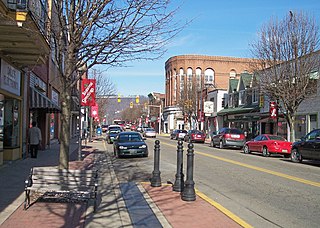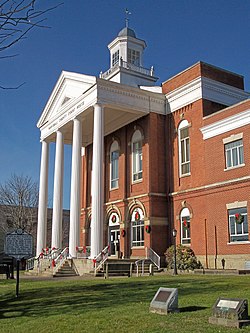
The Henry K. List House, also known as the Wheeling-Moundsville Chapter of the American Red Cross, is a historic home located at 827 Main Street in Wheeling, Ohio County, West Virginia. It was built in 1858, and consists of a two-story square main block with an offset two-story rear wing. The brick mansion features a low-pitched hipped roof with a balustraded square cupola. It has Renaissance Revival and Italianate design details. The building was once occupied by the Ohio Valley Red Cross.

The Hinton Historic District is a national historic district located at Hinton, Summers County, West Virginia. The original Hinton Historic District is bordered roughly by the Chesapeake and Ohio Railroad line, James Street, 5th Avenue, and Roundhouse. The boundary increase extended the district to include Mill Street. It encompasses 212 contributing buildings, one contributing structure, and two contributing objects. They include the business and commercial core of Hinton and surrounding residential areas. The buildings are largely two and three story with first floor commercial activities with offices and apartments above. Many of the buildings feature stone trim and some have cast iron store fronts. Residential buildings are representative of popular late 19th- and early 20th-century architectural styles. Notable buildings include the Wagon Wheel Restaurant (1876), Summers County Library, R.R. Flanagan Building, Lowe Furniture Company Building, former National Bank of Summers building, O. Ike Keaton residence, Bluestone Tire Company building, C&O Railway Passenger Station, Y.M.C.A., First Baptist Church (1913), Hotel McCreery, Ewart-Miller Building, McCreery / Palmer residence, Carnegie Library, Summers County Jail (1870s), and U.S. Post Office. Located in the district is the separately listed Summers County Courthouse.

The Pence Springs Hotel Historic District is a national historic district located at Pence Springs, Summers County, West Virginia. It encompasses seven contributing buildings and two contributing structures. They are the Pence Springs Hotel Building (1916-1918), Pavilion / Casino (1919), Hotel Manager's Residence / Warden's Residence, Hotel Garage (1925), Golf Caddy House (1919), Pence Springs Bottling Works, and Pence Springhouse.

Gerrardstown Historic District is a national historic district located at Gerrardstown, Berkeley County, West Virginia. It encompasses 92 contributing buildings, 4 contributing sites, and 2 contributing structures. Notable commercial buildings include the Gerrardstown Corner Store, Wiest Antiques Store, Richard McCormick Store, Charles Crim Store, and David S. Griffith General Store. Most houses are 2 1/2 stories and are representative of a number of popular architectural styles including Queen Anne, Federal, and Greek Revival. Religious properties include the Presbyterian Church (1893) and Cemetery and Southern Methodist Episcopal Church (1883). Also included is the Lutheran Cemetery with burials dating to 1818. Located within the district is the separately listed Hays-Gerrard House.

Nellis Historic District is a national historic district located at Nellis, Boone County, West Virginia. It encompasses 82 contributing buildings, three contributing structures, and one contributing object. The district includes the commercial, ecclesiastical, and residential buildings built by the Nellis Coal Company as a planned community between 1920 and 1955. The community was a model for coal communities in Boone County and the southern coal fields. Included in the district is the Nellis Church / Nellis Archives (1926), stone wall constructed by the Works Progress Administration, coal company storage building, Nellis Company Store and Offices (1922), community bulletin board, Superintendent's House, and clubhouse.

West Union Downtown Historic District is a national historic district located at West Union, Doddridge County, West Virginia. It encompasses 27 contributing buildings that include the commercial and civic core of the town, and surrounding residential buildings. The district includes a number of buildings representative of popular architectural styles from the late-19th century and early-20th century including Romanesque Revival, Neoclassical, and Queen Anne. Notable buildings include the Doddridge County Courthouse (1903) and Jail, Scott W. Stuart House, Silas P. Smith House, Town Hall (1893), Droppleman Residence, Michel's Pharmacy (1925). Empire Oil Building, and Myles Manufacturing Co., Inc.. Also located in the district is the separately listed Silas P. Smith Opera House.

Ferrell-Holt House, also known as "Kirkside," is a historic home located at Moundsville, Marshall County, West Virginia. It was built in 1877, and is a two-story masonry dwelling in the Italianate style.

Bushrod Washington Price House, also known as the Price-Burley House, is a historic home located at Moundsville, Marshall County, West Virginia. It was built about 1830, and is a five bay, "L"-shaped brick dwelling in a Greek Revival / I-house style.

Cameron Downtown Historic District is a national historic district located at Cameron, Marshall County, West Virginia. It encompasses 27 contributing buildings in the commercial core developed after a severe fire in 1895 which destroyed much of the downtown area. They are large 2-4 story brick buildings reflecting the Classical Revival and Colonial Revival styles. Notable buildings include the Masonic Lodge 17, Romine Building/Moose Lodge 758, First Presbyterian Church (1907), First United Methodist Church (1894), Hotel Main, Finlayson's 5 & 10/ Senior Citizens Building, Flatiron Building (1896), First Christian Church of Cameron (1896), and Old B&O Freight Station (1878).

Downtown Huntington Historic District is a national historic district located at Huntington, Cabell County, West Virginia. The original district encompassed 59 contributing buildings; the boundary increase added 53 more contributing buildings. It includes the central business district of Huntington, and includes several of its municipal and governmental buildings. It contains the majority of the historic concentration of downtown commercial buildings. Notable buildings include the Huntington City Hall, Johnson Memorial Church (c.1886/1912/1935), Trinity Episcopal Church (1882), Davis Opera House, Love Hardware Building, Reuschleins Jewelry building (1923), the Newcomb Building, the Morrison Building (1919), Keith-Albee Theater (1928), West Virginia Building, and Gideon Building. Located in the district are the separately listed Carnegie Public Library, Cabell County Courthouse, U.S. Post Office and Court House, and Campbell-Hicks House.
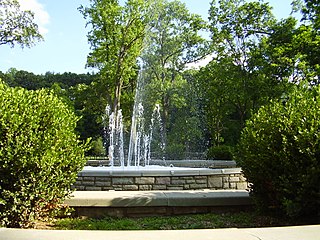
Ritter Park Historic District is a national historic district located at Huntington, Cabell County, West Virginia. The district encompasses 68 contributing buildings and 5 contributing structures, including the Ritter Park municipal park. The city purchased the park property in 1908. Dwellings in the district represent the finest styles in popular architecture from the years 1913 to 1940, including Colonial Revival, Bungalow/craftsman, and Tudor Revival. Notable buildings include the Ritter Park Apartments (1932), Weingartner House, Cammack House (1923), Marshall University President's House (1923), and Park Terrace Apartments.
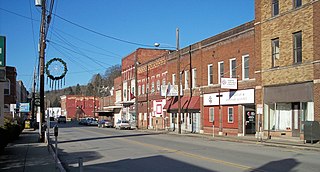
Salem Historic District is a national historic district located at Salem, Harrison County, West Virginia. The district encompasses 28 contributing buildings in the central business district developed after a devastating fire in 1902. The district is almost exclusively commercial, with the exception of a few residences. Notable buildings include the B & O Railroad Station (1912), Cozy Corner, Salem Baptist Church, First National Bank, U.S. Post Office, Brissey Insurance Building, Wilson Building, and the Queen Anne style Pearcy-Randolph House, former home of Senator Jennings Randolph.

Pratt Historic District is a national historic district located at Pratt, Kanawha County, West Virginia. The district includes 67 contributing buildings and one contributing site. The primarily residential district includes some notable commercial, ecclesiastical, civic, and industrial buildings dated as early as the 1820s. Notable buildings include the Charles Pratt Mining Company office, I.O.O.F. Building, Samuel Hanna House, Jim Shields Corner, James Trimble House, Weaver-Grose House, Burke-Mooney House, Boyer House, The Blue House, Perry-Holt House, Old Town Hall, The Cooperage, and Pratt Cemetery. The delisted Mother Jones Prison was once located in the district.

Bluefield Downtown Commercial Historic District is a national historic district located at Bluefield, Mercer County, West Virginia. The district includes 73 contributing buildings in Bluefield's central business district. The buildings are primarily three and four story masonry commercial buildings. Notable buildings include The Shamrock Restaurant (1885), People's Bank (1895), the Art Deco / Moderne style Colonial Theatre and Appalachian Power Company building, Law and Commerce Building, Benevolent Protective Order of Elks Building, First Christian Church (1920), Elizabeth Kee Federal Building and Post Office (1911), Bluefield Sanatorium, and West Virginia Hotel (1923) designed by Alex B. Mahood. Located in the district is the separately listed Municipal Building.
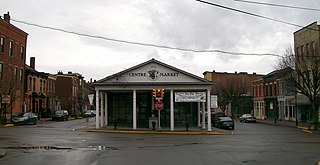
Centre Market Square Historic District is a historic district in Wheeling, West Virginia, listed on the National Register of Historic Places.

Downtown Rowlesburg Historic District is a national historic district located at Rowlesburg, Preston County, West Virginia. The district encompasses 51 contributing buildings and 1 contributing site in the central business district and surrounding residential areas of Rowlesburg. Most of the commercial buildings are two story, frame and masonry buildings, dating from about 1900 to 1950. Notable buildings include the St. Paul's Methodist Protestant Church (1923), St. Philomena's Roman Catholic Church, Trinity Methodist Episcopal Church (1915), Rowlesburg School, Waybright House, Weaver House, Nassif Home and Store building, Rowlesburg Area Historical Society/IOOF building (1875), and Adams and Moore Store building (1907).

Hume Historic District is a national historic district located at Hume, Fauquier County, Virginia. It encompasses 59 contributing buildings in the rural village of Hume. The majority of the buildings in the district are vernacular in nature and are late-19th- to early- 20th-century frame dwellings of the side-passage and I-house form. It also contains three commercial buildings, a church, two schools, and a former tavern. Notable buildings include Barbee's Tavern, "The Dell," the parsonage for Leeds Church, former Captain Marshall's Store, the African-American Hume School, the former Hume Methodist Church, and the Hume Baptist Church (1921).

Paris Historic District is a national historic district located at Paris, Fauquier County, Virginia. It encompasses 53 contributing resources in the rural village of Paris. The district includes primarily residences, although the district also includes some commercial buildings, churches, a former school, and a cemetery. Fifty-two of the 53 contributing resources are already listed as part of the Crooked Run Valley Rural Historic District. Notable buildings include "Wagoner's Stand", the Josiah Murray House, the William Peck House, Old Paris Meeting House, the Willis-Carr House, the former Rogers Store, and Trinity United Methodist Church (1892).

Rocky Mount Historic District is a national historic district located at Rocky Mount, Franklin County, Virginia. It encompasses 211 contributing buildings, 2 contributing sites, 1 contributing site, and 2 contributing objects in the central business district and surround residential areas of Rocky Mount, county seat of Franklin County. It includes residential, commercial, institutional, and governmental buildings dated from the early- to mid-19th through early 20th centuries. Notable buildings include the Rakes Building (1929), N&W Freight Depot, Mount Pleasant (1828–1829), The Taliaffero Building (1827–1828), The Grove (1850), McCall House, Lodge Rooms (Colored), Trinity Episcopal Church, Rocky Mount Presbyterian Church, Baptist Church (Colored), N. Morris Department Store / Bryd Balm Company, Franklin County Courthouse (1909), Franklin County Jail (1938), Franklin County Library (1940), Rocky Mount Municipal Building (1929), and a Lustron house known as the Davis House (1949). Located in the district and separately listed are the Woods-Meade House and the Greer House.

Charlottesville and Albemarle County Courthouse Historic District, also known as the Charlottesville Historic District is a national historic district located at Charlottesville, Virginia. The district encompasses the previously listed Albemarle County Courthouse Historic District and includes 269 contributing buildings and 1 contributing object in the city of Charlottesville. It includes the traditional heart of the city's commercial, civic, and religious activities, with early residential development and industrial sites located along the fringe. The commercial core is located along a seven block Downtown Mall designed by Lawrence Halprin (1916-2009). Notable buildings include the Albemarle County Courthouse, Levy Opera House, Number Nothing, Redland Club, Eagle Tavern, United States Post Office and Courts Building (1906), Christ (Episcopal) Church (1895-1898), Beth Israel Synagogue (1882-1903), Holy Comforter Catholic Church (1925), First Methodist Church (1924), McIntire Public Library (1919-1922), and Virginia National Bank (1916). Also located in the district are the separately listed Abell-Gleason House, William H. McGuffey Primary School, Thomas Jonathan Jackson sculpture, Robert Edward Lee sculpture, and Marshall-Rucker-Smith House.
